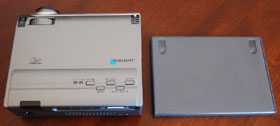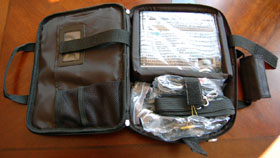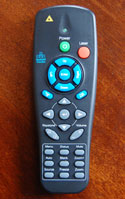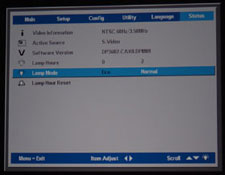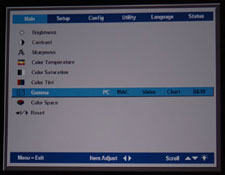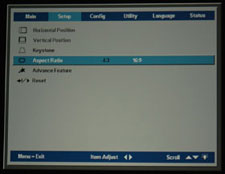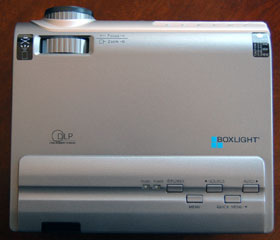 |
; |
Compromise. Life is almost always about compromise. When it comes to the traveling business executive or academic trainer, etc., the lighter and more compact the projector is, the better. This usually necessitates throwing performance by the wayside and hoping that your travel-friendly projector can at least do a decent job. With Boxlight’s TraveLight2 – that very rare sequel that doesn’t suck – you no longer have to hope or compromise performance in the name of ultra-portability. FIRST IMPRESSIONS – Boxlight DLP ProjectorStyle & Appearance The Boxlight TraveLight2 is classified as an ultra-portable projector. I’ve learned that in the crowded universe of all things projector, the stringent criterion outlined to qualify as such requires a projector to (barely) tip the scales at five or less pounds, or 2.3 kilograms. In the case of the TraveLight2, Boxlight has slashed that figure in half, with this projector weighting in at an insanely modest 2.5 pounds, or 1.1 kilograms. Perhaps a new classification name is in order, but as things stand now, the TraveLight2 is amongst one of the lightest projectors currently on the market that can output 2000 or more ANSI lumens – a figure usually reserved for the larger, heftier projectors. But being ultra-lightweight isn’t enough. You also have to be compact. The TraveLight2 is certainly this as well, with dimensions of (W x H x D): 7.7 x 6.4 x 2.2 inches, or 19.6 x 16.3 x 5.6 centimeters. This super-small, yet stellar package (barely bigger than a standard DVD case) comes in a dark gray color case with silver accents, featuring a stylish design that benefits from a nice blend of rounded contours and straight edges.
Looking at the DLP projector head-on, the far right-hand side features the lens that offers focus and zoom functionality with a 1.16:1 zoom ratio. The lens cover comes with a handy string attached between it and the projector so you never have to worry about losing it. The mid to left-most region of the projector houses the air vent that’s smartly angled away from the lens; up top and near the back (essentially in-line with the air vent), you’ll find the hard-top buttons which offer Power, Menu, Quick Menu, Source, and Auto, as well as light indicators for the power and lamp. The projector’s rear contains all of the input connections which I’ll discuss in more detail further down, and up front and centered under the bottom of the projector, you’ll find a button which can adjust the height of the projector.
A really nice, added-value bonus that you get with the TraveLight2 is a carrying case (with an optional attachable shoulder strap) which safely stores the projector on the right side, while the left side is used for all of the cables that come with the projector. In this regard, Boxlight has spared no expense, giving you a power cord (of course), an S-Video to Composite cable, a Composite cable, a DVI to VGA cable, a USB cable, and an audio cable. Let’s now look at the connectivity for the TraveLight2. Getting Connected In keeping with the ultra-compact, ultra-lightweight, and ultra-portable motif of the TraveLight2, the rear input connections are as simple and streamlined as it gets. You have inputs for DVI-I, two-in-one Composite/S-Video, USB, and Audio. As mentioned above, all of the cables are provided to suit most any cable configuration you’ll be using such as DVI to VGA or S-Video to Composite. Everything is clearly labeled for ease of use, and nicely laid for ease of access.
Remote Control PERFORMANCE – Boxlight DLP ProjectorSet-Up Now that you’ve got the projector unpacked and ready to go, it’s time to set it up. As you’d expect with most portable, presentation projectors, the zoom lens is somewhat limited at 1.16:1, so if you’re looking to throw a 100-inch image, anticipate leaving a good 14 feet worth of distance between the TraveLight2 DLP projector and your screen. Once you’ve established distance and placement, the next order of business to familiarize yourself with the various menu options. For such a compact, ultra-portable projector, the TraveLight2 does not skimp on options, offering a really nice blend of practical and useful features. The first menu you’ll be presented with is the Main menu. Here you’ll find a slew of adjustment controls for items such as Brightness, Contrast, Sharpness, Color Temperature, Color Saturation, and Color Tint; the latter two are only available when connected via a video source. Further, you also have options to adjust for Gamma and Color Space. Gamma, in particular, has five available settings that can be used depending on the nature of the input device you have connected. The settings include PC, MAC, Video, Chart, and B&W. Each offer their own respective Gamma and Brightness rating that is provided to you in the CD-only user manual. The next menu, Setup, has options which include Keystone, Aspect Ratio, and Advanced Feature. Advanced Feature opens up an additional menu of options to give you even more control over your projected images. Here you can access the Auto Keystone feature as well as User Color which lets you customize on a 0 to 100 scale, colors such as red, green, blue, cyan, magenta, yellow, and white. There’s also a security lock, power-up password feature here that aids against an unauthorized person accessing your projector. A nifty feature to be sure, but the rub here is that if you misplace or forget the password (or a particularly malicious person times it out on purpose), you need to contact Boxlight to have the password reset, as the projector will not power on. This is definitely not something you need during crunch time, so either jot the password down, keep company with only good, wholesome people, or forget about using this particular feature altogether. If that wasn’t enough, there’s also a Fan Speed feature which, when set to high, allows the projector to work in attitudes great than 10,000 feet (3000 meters). The TraveLight2 also offers four more menus: Config, Utility, Language, and Status. Highlights in the Config menu include Auto Source which enables the projector to automatically find your input device, saving you all that button toggling. The Utility menu allows you to select your projection method (two are available: desktop mount front and desktop mount rear), and there’s also a Digital Zoom feature that allows for digital pan and zoom adjustment. The Language menu is self-explanatory allowing you to adjust your menu language from a list of over 10. Finally, the Status menu is where you can find all the info regarding your lamp hour usage, your video and source settings, along with Lamp Mode which allows you to choose between Eco and Normal depending on the specifics of where you’re using the projector. Eco offers lamp life of up to 5000 hours, while Normal offers lamp life of up to 4000 hours.
Out-Of-Box Picture I first tried the TraveLight2 projector with out of the box settings, using some PC apps that included PowerPoint, Word, and Photoshop. It did a particularly good job with text, rendering everything in clear and clean detail, allowing even the smallest of fonts to be perfectly legible. With regards to photos and more detailed images, there was a good amount of detail and depth to the images, though they did lack the vivid punch that you tend to get with LCD-powered projectors. Some prefer the look of DLP; some prefer the look of LCD, as what’s pleasing to the eye can be an entirely subjective experience. Personal opinion aside, the TraveLight2 performed quite well out of the box, and the remote control was intuitive and very convenient when it came to scrolling through various slides and images. Seeing if I could improve things, I followed that up by making the following adjustments below:
One thing I did note with the various sub-options that were available within the Gamma setting is the various pros and cons each one had. While I settled on PC, as it seemed to offer the best balance of them all, Chart was best for text, and B&W, being the brightest of the bunch, offered the most LCD-like image, though this came at the expense of some of the finer details in the images..
While the TraveLight2 – geared towards business and academic presentations for the portable-minded consumer – is not designed or marketed as a home theater or video projector, I did hook it up with my JVC DVD player using the S-Video to Composite cable that Boxlight provides to see how it would perform on this level. The test subject was Death to Smoochy, and to my surprise, the verdict was better-than expected. While color gamut was somewhat lacking, and the bright, vivid colors that define this movie were less so, the images did offer a nice, rich, textured look with good whites and decent blacks. I then made the following adjustments in the Main Menu:
I also adjusted the White Peaking in the Setup menu (Advanced Feature) from 10 to five. The notable area of improvement was in the details displayed during the darker segments of the movie. The bottom line here: in the area of DVD video playback, the TraveLight2 performed as well as could be expected considering the limitations of DVD – especially in the light of, and in comparison to, the HD explosion currently gripping the world of consumer electronics. Calibration After running a calibration on the TraveLight2, the above average out-of-box performance and functionality of this DLP projector was confirmed via how close the by-eye image adjustments were to the final calibrated numbers. While the projector did favor a blue push, and an ever-so slight red one, it was nothing out of the ordinary, and was hovering at an absolute color temperature of 6625K in the mid-IRE ranges. In terms of the net results that calibrating had on the actual image quality (PC apps), I would say that they were mostly indistinguishable with respect to the virtually equal improvements one could make solely by adjusting the settings available in the standard user menu. In the video arena, the image came off a little better, with most of the improvements apparent in the color accuracy and contrast detail during the scenes with a darker flavor to them. In short, with a healthy dose of user options available right out of the box, I’d recommend sticking with those when having to tweak your image. FINAL THOUGHTS – Boxlight DLP ProjectorAs mentioned off the top, compromising is a fact of life, and it’s generally an act of hoping that gaining in one area, while losing out in another, will not solely be a back and forth exercise in lateral improvement. With the TraveLight2 by Boxlight, they’ve managed to create a multipurpose DLP presentation projector that is ultra-light, ultra-compact, and ultra-portable, without short-changing quality, performance, and dependability. Offering superb out-of-box functionality, and a great host of available user options, when it comes to the executive or trainer or teacher who wants to travel really light, yet perform with the massive weight of genuine quality, than the Boxlight TraveLight2 is just for you.
DETAILED SPECIFICATIONS – Boxlight TraveLight2 DLP Projector
Highly Recommended
Video Projector Reviews
|
JVC DLA-X30 Review |
|||||||||||||||||||||||||||||||||||||||||||||||||||||||||||||||||||||||||||||||||||||||||||||||||||
|
Home • Projector Brands • Video Projector Reviews • Projector Resources • Contact Us
|

